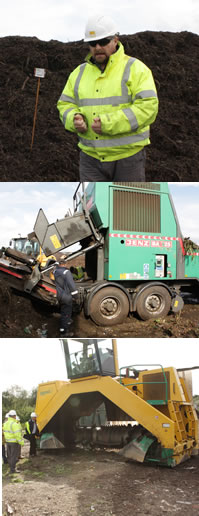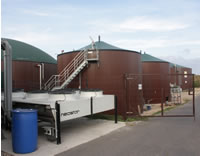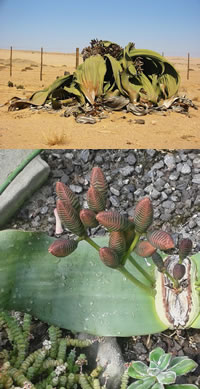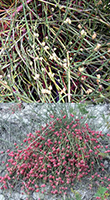In early October we visited the ECO composting company in Dorset to see their composting plant at Parley near Bornemouth and aerobic digestion complex at Piddlehinton near Dorchester. On this occasion we did not see their massive solar farm also at Parley but that could form the basis of a future return visit. A report on our tour can be found below.
On 2 December we will be joining the Professional Horticulture Group South West for their annual Christmas lunch at Lackham College. In addition to the lunch a guest speaker is always invited.
We are also considering events for 2017 and beyond. Already in the pipeline is a visit to the Royal Botanic Gardens Kew to see their science programme and hopefully a preview of the renovated Temperate House. A tour of Cambridge College gardens is being planned by our own Margaret Waddy who is now a qualified Cambridge tour guide (congratulations Margaret). Other trips in the pipeline are visits to the jam and preserve production of Wilkin and Sons at Tiptree in Essex and a Sussex vineyard.
Peter Grimbly
Contents
Putting organic waste to use
Plant of the Month
Medicinal Plant of the Month
News from our Associates
Horticulture Industry News
Events Calendar
Horticulture Group contact details
Related Links
Putting organic waste to use

Our host for the day, Technical Manager Mike Thompson (pictured top), explained that every vehicle is weighed in and out of the site and charged according to the weight difference for the privilege of leaving its load. Compostable waste is collected in one area for processing while the timber goes to another part of the site. The latter is simply loaded into large lorries and taken to Southampton docks where it is chipped and then exported to Sweden where it is used to generate electricity.
The compostable waste is ‘chipped’ on site in a machine far removed from the shredders familiar to gardeners and landscapers (pictured middle right). The rapidly rotating drum of this machine is covered in hammers which crunch the waste against a steel bar. Although kitted with hi-viz jackets and safety helmets we were encouraged not to approach too closely! Once processed the waste is piled in long windrows and allowed to compost naturally with nothing extra added. The internal temperature of the windrows in monitored daily to ensure the internal temperature is high enough and they are turned as required by a large machine similar in action to those used to prepare mushroom compost (pictured lower right). Initially windrows may be turned twice a week but normally around one a week.

What arrives at the site is all classified as waste and is covered by a raft of rules and regulations. Every movement off site would require copious form filling. The primary objective therefore is to convert the material into a product that is no longer classified as waste and thus becomes free of this legislation and form filling.
Even further behind the composting site, and the part we did not visit on this occasion, lies the country's largest array of solar panels. Largely hidden from view this part of Eco’s business is best viewed from planes arriving and departing at the airport or, more cheaply, on Google Earth.
The one organic waste that is no longer dealt with at their Parley site is food waste. It used to be composted in large covered sheds adjacent to the composting windrows of green waste. Now it is used as fuel to supply anaerobic digesters (picture right) at a facility outside the village of Piddlehinton north of Dorchester. Here inside the large digester tanks anaerobic decomposition generates methane that is used to power the electricy generators that supply the local farm and the national grid.
Two problems that these digesters create are toxic hydrogen sulphide and pressure. As long as the hydrogen sulphide is kept away from humans it creates no problems and converts to sulphur, an added nutrient in the digested waste. This is supplied to local farmers as an organic supplement for their fields.
Pressure in small quantities is a bonus as it helps force the gases to the power plant however excess could cause the tanks to explode with devastating results. The tanks are therefore fitted with pressure release systems to cope with any excess and burn off the surplus gasses.
Peter Grimbly
Plant of the Month

Surely one of the most incredible plants on our planet, Welwitschia is native to the Namib Desert in southern Angola and Namibia. This is the only species in the genus, the only genus in the family and is most closely related to two other families – Ephedraceae and Gnetaceae. Together these three families are known as Gnetopsida. They have features shared by both angiosperms (flowering plants) and gymnosperms (seed plants not considered to be angiosperms).
Welwitschia is a very long lived plant – potentially to 1500 years or more and the single pair of leaves that grow throughout the lifetime of the plant can grow up to nearly 14cm per year. The leaves can ultimately reach 1m across but the length does not continue to extend indefinitely as the leaves wear away at the end. Picture upper right by Thomas Schoch).
The winged seeds germinate in wet years, and the seed leaves (cotyledons) continue to photosynthesise for 18 months. The apical meristem is lost and two scale-like leaves develop and engulf the shoot apex. Fertile buds are produced on the 'crowns' between the leaf bases – from where the inflorescence grows. Each plant is either male or female – it is a dioecious species.
This species is named for Friedrich Welwitsch (1806-1872), an Austrian botanist and doctor who discovered the plant in 1859 in what is today Angola. It was formally described by JD Hooker using the description provided by Welwitsch and material he had collected. Although Welwitsch indicated that he would like the genus to be called Tumboa (after what he believed to be the local name), Hooker asked him if he could name it after him.
It is relatively easily grown from seed, although tricky to transplant due to the tapering taproot and delicate nature of the rooting system.
This plant grows in an extremely low rainfall region but is most commonly found along ephemeral watercourses. It obtains much of its moisture through the dry season from coastal fogs. It uses the CAM (Crassulacean Acid Metabolism) modification of photosynthesis, where gas exchange happens during the hours of darkness to minimize evapotranspiration.
Lower picture. A welwitschia 'coning' at the University of Konstanz Botanic Garden, October 2016.
Alison Foster
Royal Botanic Gardens Kew
Medicinal Plant of the Month for November 2016

Ephedra or Ma Huang, contains ephedrine and pseudoephedrine in varying amounts depending on the particular species. Ephedrine was reportedly first isolated from Ephedra distachya (syn. Ephedra vulgaris) in the 1880s by a Japanese chemist (although recent scientific studies of this plant have failed to find ephedrine in it). Ephedra sinica is the species with the highest alkaloid content (1 to 3% of dry weight) with ephedrine making up 40 to 90% of the total alkaloids. Ephedrine has been used in the past to treat asthma but nowadays is only occasionally used as a decongestant. Many over the counter preparations have pseudoephedrine in them which also acts as a decongestant. Preparations of the whole herb, sold as ephedra, often contain a mixture of species, not all of which contain the active alkaloids. Ephedrine is on the banned substance list issued by the World Anti-Doping Agency.
Upper Picture; Ephedra siniaca by Alex Lomas
Lower Picture; Ephedra distachya by Le.Loup.Gris
Alison Foster
Royal Botanic Gardens Kew
News from our Associates
Commercial Horticultural Association

Expo Haarlemmermeer, Vijfhuizen, Holland on 2-4 Nov 2016. This will be followed by stands at; Growtech Eurasia, 30 Nov - 4 Dec: IPM Essen, 24 - 27 Jan 2017 and Fruit Logistica 8-10 Feb 2017. For details of exhibiting at any of these show and grants available visit the CHA website.
Royal Society of Biology

Horticulture Industry News
Sound waves delay tomato fruit ripening.....
Researchers have shown that sound waves can delay the normal ripening of tomato. Green fruit were treated with low-frequency sound waves (1 kHz) for 6 h, and then monitored various characteristics of the fruit over 14-days. Seven days after the treatment, 85% of the treated fruit were still green while fewer than 50% of the non-treated fruit. Ethylene production and respiration rate were lower in the sound-treated than non-treated tomatoes. The expression level of several ethylene biosynthetic and ripening-regulated genes was influenced by sound wave treatment. More
....but should they be refrigerated
Other researchers looked at what happens when a tomato goes into your kitchen fridge, or into the tomato industry's refrigerated trucks and storage rooms. Some components of a tomato's flavour were unaffected, such as sugars and acids. But they found that after seven days of refrigeration, tomatoes had lower levels of so-called aroma compounds that easily vaporize. In blind taste tests people could definitely tell the difference and tomatoes that weren't chilled got better ratings. The scientists found that cold temperatures actually turned off specific genes, and that, in turn cut down production of the flavour compounds. More
Water-saving farming tech adopted in Japan
Working with a startup, Japanese chemical company has commercialized a new soil-less cultivation system. The method involves growing plants on a polymer film containing nutrients, and offers the advantage of greatly reducing the volume of water and fertilizer used, compared to conventional hydroponics. In Japan, the method has already been adopted for growing tomatoes. Crops are grown by placing a water-stopping sheet and nonwoven cloth on the ground and spreading the polymer film on top of that. Humic acid, is used to stimulate the action of the roots. A tube installed under the film is used to supply liquid fertilizer. Compared to conventional hydroponics, this method reduces the quantity of both water and fertilizer needed by more than half. It can also boost harvests by around 10%.
Tech 'will shape industry more than Brexit'
Technological advancements and the growth of robotics will prove more important than Brexit in reshaping the grocery industry, the Institue of Grocery Distribution’s chief economist predicts. He suggests that the economic impact of Brexit should not be exaggerated, but argues that it is of lesser importance than wider political changes affecting the food industry. He feels that Brexit is just one of a series of much wider political changes that we have to be aware of including the emergence of new technologies, which have the potential to undermine a lot of the advantages of international trade and scale economies. This would make a post-Brexit shake-up of trade agreements and reduce the extent to which globalisation is a driver of prosperity and growth - a movement that he says is 'running out of steam'. More
Field to be farmed exclusively by robots
In a world-first Harper Adams University is attempting to grow and harvest a hectare of cereal crops; all without stepping a foot into the field. The project entitled ‘Hands Free Hectare’ has recently got underway, with the team having to create their first autonomous farming machinery, ready for drilling a spring crop in March. Previously, people have automised sections of agricultural systems. This time they are hoping to string everything together to create one whole system, which will allow them to farm one hectare of cereal crop from establishment to harvest, without having to go into the field. They will be using small-scale machinery that is already available on the market, and adapting these in the university’s engineering labs ready for the autonomous field work. More
Soybean nitrogen breakthrough could help feed the world
Researchers have developed a way to dramatically increase the yield and quality of soybeans by fixing twice as much nitrogen from the atmosphere as their natural counterparts. For years, scientists have tried to increase the rate of nitrogen fixation in legumes by altering rhizobia bacterioid function or interactions that take place between the bacterioid and the root nodule cells. Using a different approach they increased the number of proteins that help move nitrogen from the rhizobia bacteria to the plant's leaves, seed-producing organs and other areas where it is needed. These additional transport proteins sped up the overall export of nitrogen from the root nodules. This initiated a feedback loop that caused the rhizobia to start fixing more atmospheric nitrogen, which the plant then used to produce more seeds. They were bigger, grew faster and generally lookeD better than natural soybean plants.
Ghost tree mystery solved?
Amongst the redwood forests of western USA albino trees completely lacking chlorophyll can be found. They obtain all their nutrients by tapping into the root system of normal green trees. Researchers have been investigating why normal trees seem happy to support these apparent ‘parasites’. They found that the needles of albino trees were saturated with what should have been a deadly cocktail of cadmium, copper and nickel. They now believe that the albino redwoods are in a symbiotic relationship with their healthy brethren and may act as a reservoir for poison in exchange for the sugar they need to survive.
For the very latest horticultural news follow us on Facebook,
Twitter, or
LinkedIn
Events Calendar
Agrobiodivestity
6 - 9 Nov 2016,
New Delhi, India
Taming Plant Viruses
8 - 10 Nov 2016, Biochemical Society
Pitlochry, UK
Phytobiomes
8 - 12 Nov 2016, Keystones Symposia
Santa Fe, USA
Advances in IPM
16 - 17 Nov 2016, Association of Applied Biologists
Grantham, UK
Tropical and Temperate Horticulture
20 - 25 Nov 2016, International Society of Horticultural Science
Cairns, Australia
Saffron Biology
23 - 26 Nov 2016, National Institute of Agronomic Research
Agadir Morocco
Sensors in Food and Agriculture
29 - 30 Nov 2016,
Cambridge, UK
Latest Advances in Plant Development & Environmental Response
29 Nov 2016 - 2 Dec 2016, Cold Spring Harbour Laboratory
Awaji, Japan
Policy priorities for the UK food, drink and farming industry
1 Dec 2016, Westminster Food & Nutrition Forum
London, UK
Natural Variation as a Tool for Gene Discovery and Crop Improvement
12 - 13 Dec 2016, Garnet
Cambridge, UK
Advances in nematology
13 Dec 2016, Assiciation of Applied Biologists
London, UK
Plant Synthetic Biology and Bioengineering
16 - 18 Dec 2016, Society for Biologial Engineering
Miami Beech, USA
Frontiers of Potassium
25 - 27 Jan 2017, International Plant Nutrition Institute
Rome, Italy
If you would like to advertise a forthcoming event please contact. julia.duckworth@soci.org
Horticulture Group Contact Details
For submitting ideas or to volunteer to be part of a committee or a group, please contact:
Chairman - Tony Girard
Secretary - Alison Foster
Meetings Coordinator - Peter Grimbly
Newsletter co-ordinator - Sue Grimbly scihortigroup@btinternet.com
Group Contact - Julia Duckworth, E: julia.duckworth@soci.org T: +44(0)20 7598 1584

